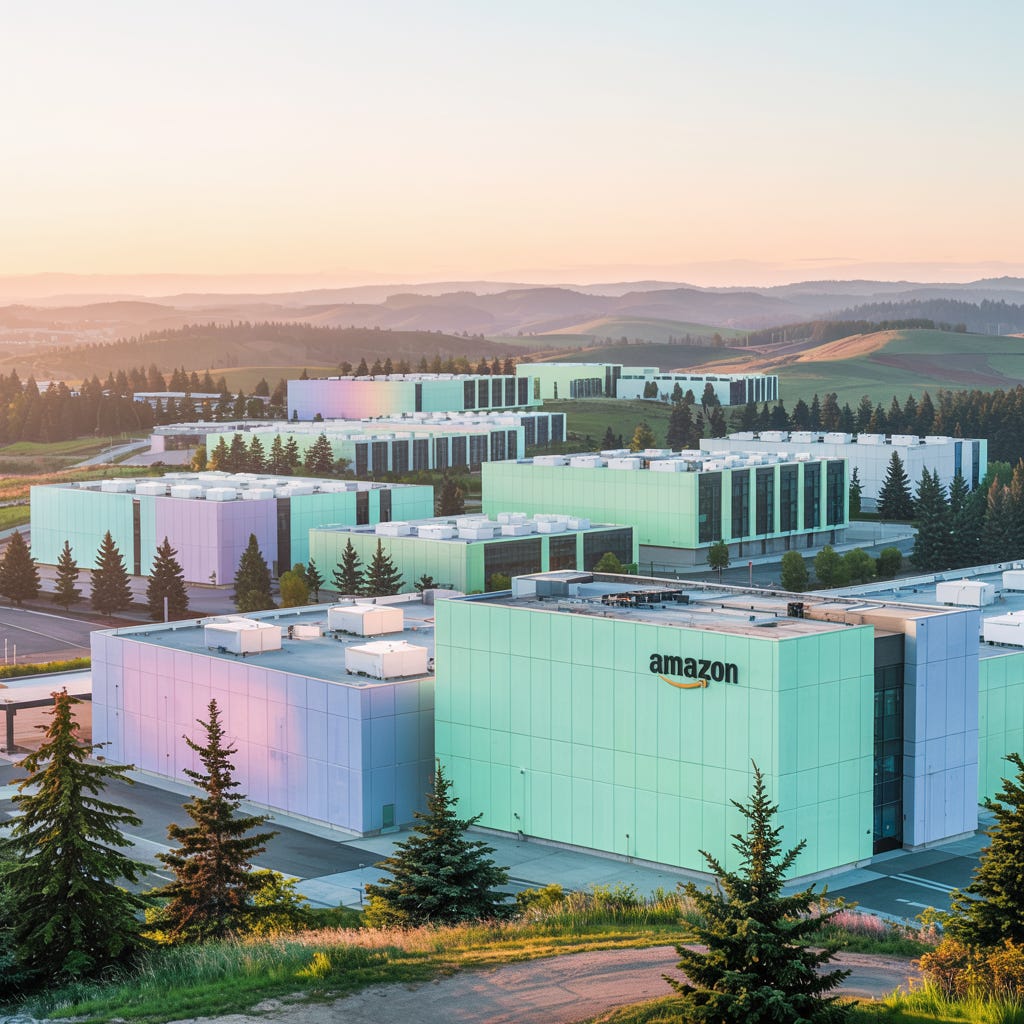Amazon Q3 2025: The $125B AI Infrastructure Pivot Driving AWS Re-Acceleration
Inside Amazon’s record-breaking AI infrastructure buildout, global data center expansion, and the strategic bets defining its next decade of cloud leadership.
Welcome to Global Data Center Hub. Join investors, operators, and innovators reading to stay ahead of the latest trends in the data center sector in developed and emerging markets globally.
Amazon’s third quarter wasn’t about quarterly beats it was a declaration of infrastructure intent. The company reported $180.2 billion in revenue, up 13 percent year-over-year, with earnings per share of $1.95, both above expectations. Yet behind those headline numbers lies a deliberate recalibration of the business around AI infrastructure scale.
At the heart of that shift is AWS, which reaccelerated to 20 percent year-over-year growth, its fastest clip in three years. The rebound was no coincidence it reflected a company willing to trade near-term free cash flow for long-term control over the physical backbone of the AI economy.
Amazon is now spending at a rate approaching $125 billion annually on capital projects, up from $83 billion a year earlier, directing the majority toward AI-ready data centers, GPU capacity, and its custom Trainium and Inferentia silicon programs. This marks a structural transformation: AWS is no longer simply a cloud platform it is becoming a vertically integrated compute utility.
Earnings and Infrastructure Strategy
Amazon’s Q3 operating income of $17.4 billion was unchanged from the prior year, but after excluding $4.3 billion in one-time legal and restructuring costs, adjusted performance showed notable improvement. Net income surged 38 percent to $21.2 billion, boosted by gains tied to AI equity holdings. Across business lines, AWS led with $33 billion in revenue and $11.4 billion in operating profit, while advertising jumped 24 percent to $17.7 billion, providing a steady margin anchor through the CapEx cycle.
North America generated $106.3 billion in revenue, reflecting automation and fulfillment efficiency, while International sales grew 14 percent to $40.9 billion, aided by FX tailwinds and disciplined cost management. These foundations continue to fund the scale-up of AWS’s physical and silicon infrastructure without compromising top-line momentum.
The AI Infrastructure Expansion
Amazon’s capital allocation signals one of the most aggressive infrastructure buildouts in corporate history. The company added 3.8 gigawatts of new power capacity over the past 12 months more than any other cloud provider enabling the rollout of next-generation, GPU-dense clusters capable of supporting high-intensity AI training workloads. Management has indicated that by 2027, total AWS-controlled capacity (operational and in-pipeline) could exceed 10 gigawatts, including multiple sovereign and hyperscale zones now under development.
Each new build combines innovations in power efficiency, rack density, and thermal control. Liquid and immersion cooling are now standard across AWS’s newest facilities, pushing compute per megawatt to new thresholds. Amazon’s hybrid silicon architecture mixing NVIDIA’s Blackwell systems with its in-house Trainium and Inferentia chips reduces cost per training run and diversifies supply risk. Together, these factors reinforce AWS’s capacity edge while positioning the platform for more efficient monetization of generative AI workloads.
Global Expansion Strategy
AWS’s global growth map increasingly mirrors geopolitical energy corridors rather than traditional data center markets. In Southeast Asia, the company is progressing plans for new regions in Jakarta, Kuala Lumpur, and Bangkok, with renewable-linked power contracts under negotiation to meet government carbon targets.
In Latin America, projects in Mexico and Brazil are advancing through land partnerships and early lease commitments from hyperscale customers in fintech and media. In India, new availability zones in Mumbai and Hyderabad are being optimized for AI workloads, supported by emerging data residency and sovereign compute mandates.
Across Saudi Arabia and the UAE, AWS is negotiating joint ventures for AI-dedicated regions backed by sovereign co-investors. These partnerships are structured around dual objectives: securing energy capacity and embedding AWS within national digital-infrastructure frameworks. Each project extends Amazon’s control over the inputs power, land, and policy that define hyperscale competitiveness.
Energy, Supply, and Local Integration
Amazon’s ability to sustain its expansion hinges on energy procurement. The company is actively finalizing multi-gigawatt renewable PPAs across Brazil, India, and Thailand, while forming joint ventures with local developers to accelerate permitting and interconnection. This model collapses multi-year development timelines into sub-24-month delivery cycles.
The strategic shift is clear: Amazon is prioritizing locations where renewable availability, political stability, and sovereign data mandates intersect. These are the geographies where long-term power certainty can be achieved and where AWS’s scale will compound fastest.
The Forward View
In the near term, AWS margins will stay compressed as the capital cycle peaks. Free cash flow is expected to bottom out in 2025 before recovering through 2026 as utilization ramps and advertising offsets infrastructure drag. The reacceleration of AWS revenue confirms that these investments are already translating into demand capture.
Beyond 2026, the company’s runway extends across both mature and emerging markets. With sovereign-cloud partnerships expanding, Trainium and Inferentia entering second-generation efficiency cycles, and cumulative AI infrastructure nearing 10 gigawatts of capacity, Amazon is transitioning from cloud vendor to AI utility.
The signal from Q3 is unmistakable: Amazon is no longer optimizing for margin it is optimizing for dominance. The $125 billion being deployed today is buying the one asset the AI era cannot scale overnight capacity. Whoever controls it, controls the future of compute.

